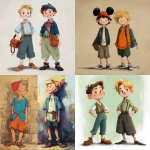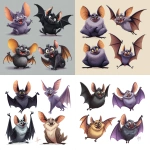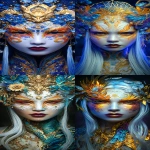Explore the Best AI Image Gallery

The AI Canvas: Reimagining Design with Intelligent Imagery
The world of design is undergoing a seismic shift, driven by the emergence of artificial intelligence (AI) and its ability to generate stunning, realistic images. This technology, once confined to science fiction, is now readily accessible, empowering designers, artists, and businesses alike to explore new creative frontiers.
AI image generators, fueled by sophisticated algorithms and vast datasets, can produce a wide range of visual content, from photorealistic illustrations and 3D models to unique abstract art pieces. This opens up a world of possibilities for designers seeking fresh ideas, rapid prototyping, and personalized visuals that cater to specific needs.
Unlocking the Potential: Use Cases Across Design Disciplines
The applications of AI-generated images in design are vast and ever-expanding. Here are just a few examples:
- Branding and Marketing: AI can create eye-catching logos, marketing materials, and social media graphics, helping businesses stand out in a crowded digital landscape.
- Website and UI/UX Design: Generate unique backgrounds, icons, and illustrations to enhance the visual appeal and user experience of websites and applications.
- Product Design: Rapidly prototype product concepts, visualize different iterations, and explore innovative designs using AI-generated 3D models.
- Editorial and Publishing: Enhance articles and stories with captivating visuals, create custom illustrations for books and magazines, and personalize content based on user preferences.
Navigating the Ethical Landscape
While AI image generation presents exciting opportunities, it also raises important ethical considerations that need to be addressed:
- Copyright and Ownership: Questions arise regarding the ownership of AI-generated images. Who holds the copyright – the creator of the AI algorithm, the user who prompts the AI, or the AI itself?
- Bias and Representation: AI algorithms are trained on massive datasets, which may contain inherent biases that reflect societal prejudices. This can result in AI-generated images that perpetuate stereotypes or lack diversity.
- Misinformation and Deepfakes: The ability to create realistic synthetic media raises concerns about the potential for misuse, such as generating fake news, impersonating individuals, or creating harmful propaganda.
Shaping the Future of Design
As AI technology continues to evolve, its impact on the design industry will only become more profound. Here are some key trends to watch:
- Increased Accessibility: User-friendly AI tools will empower individuals with limited design experience to create professional-quality visuals.
- Personalized Experiences: AI can generate customized designs tailored to individual preferences, creating truly unique and engaging experiences.
- Collaboration Between Humans and AI: Designers will increasingly work alongside AI as collaborative partners, leveraging the strengths of both human creativity and AI intelligence.
The rise of AI image generation is a transformative moment in the history of design. By embracing this technology responsibly and ethically, we can unlock its immense potential to create innovative, impactful, and visually stunning designs that shape the future.






](https://images.ai-img.art/thumbnails/150/269414b0e541026702e9e67c67602c96162f37ff460a388b3b36314c8fc936dd.webp)







](https://images.ai-img.art/thumbnails/150/485c8b1c747827bdc9a962f8a1919b3c259b18dd263b260208a1eae19fb85e07.webp)

](https://images.ai-img.art/thumbnails/150/3020b8c2b6d9be07e042357107af1de10deb274a41d2b0f332684ad4b532a702.webp)

















](https://images.ai-img.art/thumbnails/150/2fbd98ecfc425cfc1597779121e1c0305437067779e9c471eb64ff9615d5be98.webp)




](https://images.ai-img.art/thumbnails/150/8d1fe5a7a49cfc96747182431a853357913286d89258383caab2d3b4681afcb5.webp)









](https://images.ai-img.art/thumbnails/150/5197af8969d850e2a43e141d41e482ccbceedebceb2a4caf9f098f943f9d1b0f.webp)